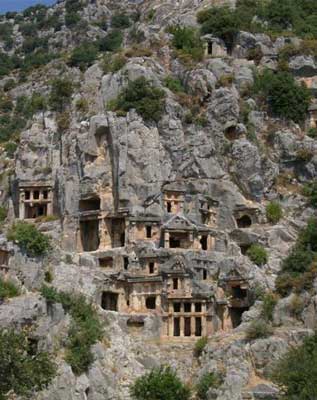.
Myra is an ancient Lycian town, where the small town of Kale (Demre) is situated today in present day Antalya Province of Turkey. It was located on the river Myros (Demre Çay), in the fertile alluvial plain between Alaca Dağ, the Massikytos range and the Aegean Sea.
Historical evidence
Although some scholars equate Myra with the town Mira in Arzawa, there is no proof for the connection. There is no substantiated written reference for Myra before it was listed as a member of the Lycian alliance (168 BC - AD 43); according to Strabo (14, 665) it was one of the largest towns of the alliance.
The Greek citizens worshipped Artemis Eleutheria, who was the protective goddess of the town. Zeus, Athena and Tyche were venerated as well.
The ruins of the Lycian and Roman town are mostly covered by alluvial silts. The Acropolis on the Demre-plateau, the Roman theatre and the Roman baths (eski hamam) have been partly excavated. The semi-circular theater was destroyed in an earthquake in 141, but rebuilt afterwards.
There are two necropoli of Lycian rock-cut tombs in the form of temple-fronts carved into the vertical faces of cliffs at Myra: the river-necropolis and the ocean-necropolis. The best known tomb in the river-necropolis is the "Lion's tomb." When the traveller Charles Fellows saw the tombs in 1840 he found them still colorfully painted red, yellow and blue.
Andriake was the harbour of Myra in classical times, but silted up later on.
In early Christian times, Myra was the metropolis of Lydia. The town is traditionally associated with Saint Paul, who changed ships in its harbor. Saint Nicholas of Myra was a bishop of Myra in the 4th century, who countered Arianism at the First Council of Nicaea in 325. It became the Capital of the Byzantine Eparchy Lycia under Theodosius II, who reigned from 408 to 450.
Siege of 809
After a siege in 809, Myra fell to Arab troops under Harun al-Rashid. The town went into a decline afterwards. Early in the reign of Alexius I Comnenus (ruled between 1081 - 1118), Myra was again overtaken by Islamic invaders, this time the Seljuks. In the confusion, sailors from Bari, Italy seized the remains of Saint Nicholas, over the objections of the monks caring for them, and spirited the bones away to Bari, where they arrived on May 9, 1087, and soon brought that city visitors making the pilgrimage to Saint Nicholas.
The church of St. Nicholas at Myra
The earliest church of St. Nicholas at Myra was built in the 6th century. The present-day church stems mainly from the 8th century; a monastery was added in the second half of the 11th century.
In 1863 Czar Alexander II of Russia bought the building and started to have it restored, but the work was never finished. In 1963 the eastern and southern sides of the church was excavated, in 1968 the former burial of St. Nicholas was roofed over. The floor of the church is made of opus sectile, a mosaic of coloured marble, and there are some remains of wall-paintings. A Greek marble sarcophagus had been reused to bury the Saint, but his bones were stolen in 1087 by merchants from Bari, and now held in the cathedral of that city.
Numismatic Links
Notes on Myra at Turkish Ministry of Culture site
Tripod site about Myra
Sites in Myra
| Ancient Greece
Science, Technology , Medicine , Warfare, , Biographies , Life , Cities/Places/Maps , Arts , Literature , Philosophy ,Olympics, Mythology , History , Images Medieval Greece / Byzantine Empire Science, Technology, Arts, , Warfare , Literature, Biographies, Icons, History Modern Greece Cities, Islands, Regions, Fauna/Flora ,Biographies , History , Warfare, Science/Technology, Literature, Music , Arts , Film/Actors , Sport , Fashion --- |
Retrieved from "http://en.wikipedia.org/"
All text is available under the terms of the GNU Free Documentation License




